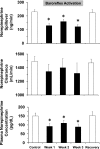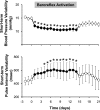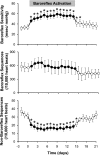Sustained suppression of sympathetic activity and arterial pressure during chronic activation of the carotid baroreflex
- PMID: 20511410
- PMCID: PMC2930387
- DOI: 10.1152/ajpheart.00372.2010
Sustained suppression of sympathetic activity and arterial pressure during chronic activation of the carotid baroreflex
Abstract
Following sinoaortic denervation, which eliminates arterial baroreceptor input into the brain, there are slowly developing adaptations that abolish initial sympathetic activation and hypertension. In comparison, electrical stimulation of the carotid sinus for 1 wk produces sustained reductions in sympathetic activity and arterial pressure. However, whether compensations occur subsequently to diminish these responses is unclear. Therefore, we determined whether there are important central and/or peripheral adaptations that diminish the sympathoinhibitory and blood pressure-lowering effects of more sustained carotid sinus stimulation. To this end, we measured whole body plasma norepinephrine spillover and alpha(1)-adrenergic vascular reactivity in six dogs over a 3-wk period of baroreflex activation. During the first week of baroreflex activation, there was an approximately 45% decrease in plasma norepinephrine spillover, along with reductions in mean arterial pressure and heart rate of approximately 20 mmHg and 15 beats/min, respectively; additionally, plasma renin activity did not increase. Most importantly, these responses during week 1 were largely sustained throughout the 3 wk of baroreflex activation. Acute pressor responses to alpha-adrenergic stimulation during ganglionic blockade were similar throughout the study, indicating no compensatory increases in adrenergic vascular reactivity. These findings indicate that the sympathoinhibition and lowering of blood pressure and heart rate induced by chronic activation of the carotid baroreflex are not diminished by adaptations in the brain and peripheral circulation. Furthermore, by providing evidence that baroreflexes have long-term effects on sympathetic activity and arterial pressure, they present a perspective that is opposite from studies of sinoaortic denervation.
Figures






Similar articles
-
Renal responses to chronic suppression of central sympathetic outflow.Hypertension. 2012 Sep;60(3):749-56. doi: 10.1161/HYPERTENSIONAHA.112.193607. Epub 2012 Jul 2. Hypertension. 2012. PMID: 22753216 Free PMC article.
-
Renal denervation does not abolish sustained baroreflex-mediated reductions in arterial pressure.Hypertension. 2007 Feb;49(2):373-9. doi: 10.1161/01.HYP.0000253507.56499.bb. Epub 2006 Dec 11. Hypertension. 2007. PMID: 17159083
-
Carotid baroreceptor stimulation, sympathetic activity, baroreflex function, and blood pressure in hypertensive patients.Hypertension. 2010 Mar;55(3):619-26. doi: 10.1161/HYPERTENSIONAHA.109.140665. Epub 2010 Jan 25. Hypertension. 2010. PMID: 20101001 Clinical Trial.
-
Electrical carotid sinus stimulation in treatment resistant arterial hypertension.Auton Neurosci. 2012 Dec 24;172(1-2):31-6. doi: 10.1016/j.autneu.2012.10.009. Epub 2012 Nov 9. Auton Neurosci. 2012. PMID: 23146623 Review.
-
The sympathetic nervous system and long-term blood pressure regulation.Am J Hypertens. 2001 Jun;14(6 Pt 2):147S-154S. doi: 10.1016/s0895-7061(01)02082-9. Am J Hypertens. 2001. PMID: 11411750 Review.
Cited by
-
Renal responses to chronic suppression of central sympathetic outflow.Hypertension. 2012 Sep;60(3):749-56. doi: 10.1161/HYPERTENSIONAHA.112.193607. Epub 2012 Jul 2. Hypertension. 2012. PMID: 22753216 Free PMC article.
-
Cardiovascular Autonomic Dysfunction in Chronic Kidney Disease: a Comprehensive Review.Curr Hypertens Rep. 2015 Aug;17(8):59. doi: 10.1007/s11906-015-0571-z. Curr Hypertens Rep. 2015. PMID: 26071764 Review.
-
Acute arterial baroreflex-mediated changes in plasma catecholamine concentrations in a chronic rat model of myocardial infarction.Physiol Rep. 2016 Aug;4(15):e12880. doi: 10.14814/phy2.12880. Physiol Rep. 2016. PMID: 27495297 Free PMC article.
-
HumMod: A Modeling Environment for the Simulation of Integrative Human Physiology.Front Physiol. 2011 Apr 13;2:12. doi: 10.3389/fphys.2011.00012. eCollection 2011. Front Physiol. 2011. PMID: 21647209 Free PMC article.
-
Sympathetic Overactivity in Chronic Kidney Disease: Consequences and Mechanisms.Int J Mol Sci. 2017 Aug 2;18(8):1682. doi: 10.3390/ijms18081682. Int J Mol Sci. 2017. PMID: 28767097 Free PMC article. Review.
References
-
- Barrett CJ, Guild SJ, Ramchandra R, Malpas SC. Baroreceptor denervation prevents sympathoinhibition during angiotensin II-induced hypertension. Hypertension 46: 1–5, 2005 - PubMed
-
- Chapleau MW, Hajduczok G, Abboud FM. Resetting of the arterial baroreflex: peripheral and central mechanisms. In: Reflex Control of the Circulation, edited by Zucker IH, Gilmore JP. Boca Raton, FL: CRC, 1991, p. 165–194
-
- Cowley AW., Jr Long-term control of arterial pressure. Physiol Rev 72: 231–300, 1992 - PubMed
Publication types
MeSH terms
Substances
Grants and funding
LinkOut - more resources
Full Text Sources
Other Literature Sources

